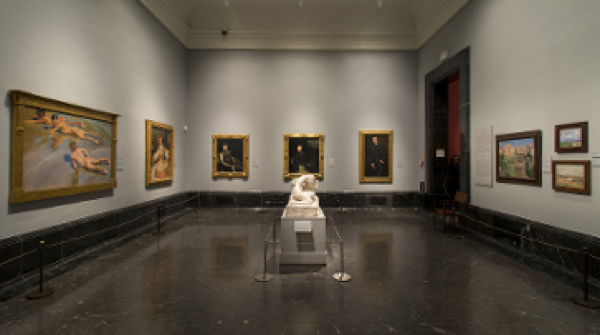Lighting The Prado
The “Lighting the Prado” project, which is sponsored by the Fundación Iberdrola España (Benefactor of the Prado Museum and Sponsor of the Museum Restoration Programme), aims to provide the Museum’s exhibition rooms, both those housing the permanent collection and those that contain temporary exhibitions, with a new LED technology lighting system to replace the previous system based on halogen lamps.
The many advantages offered by this project include
- Improvement in the conservation of the works on display, as LED technology does not give off infra-red and ultraviolet rays.
- The works are easier to view under LED light, similarly to natural light, and it also improves their presentation.
- LED technology is, on average, 75% more efficient, which translates into a significant annual saving on energy consumption.
Phases
- This important project took place in fourteen phases, starting in November 2014 and had a total duration of four years. The rooms on the ground floor of the south wing in The Prado Museum’s Villanueva building were the first ones where the results of phases 0 and 1 of this LED technology lighting project could be observed.
- In order to show the effects the project would have, for one month, Antonio Gisbert’s painting The Execution of Torrijos and his Companions on the Beach in Malaga (a large oil painting of 390 cm x 601 cm exhibited in room 61A in the Villanueva building) was illuminated with both types of lighting: the left part of the work kept the halogen lighting while the right part was illuminated with LEDs. This comparison between the lighting could also be made in other rooms such as room 63, in which only one of the works was illuminated with the new technology. These tests allowed visitors to see the differences in the quality of the chromatic reproduction of the works, as well as the visibility of the volume and the distance between the foreground and the background.
- Once phases 0 and 1 of the project were completed, other rooms were equipped with this new lighting: 60A, 61, 61A, 61B, 62, 62A, 62B, 63, 63A, 63B, 64, 65, 66, 67 and 75 , corresponding to the 19th century collections and Goya’s latter years (from 2nd and 3rd May to the Black Paintings).
From the environmental point of view, since its completion in 2017, this lighting system has yielded a 75% annual energy saving and has prevented 320 tonnes of CO2 from being emitted into the atmosphere every year. It also helps to reduce maintenance costs, as these devices have a lifetime of 50,000 hours compared to the 1,000 hours for halogen lamps.
- In 2014 alone, the implementation of these measures allowed the Prado Museum to cut its emissions by 62,9366 tCO2eq (tonnes of CO2 equivalent), a reduction of 4.55%. In addition, it consumed 117,006 kWh less natural gas, 15,206 kWh less diesel and 2,569.20 m3 water less than in 2013, which is a decrease of 23.57%, 3.31% and 5.46% respectively.

